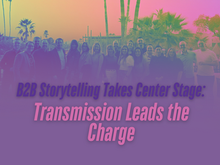Engaging the Senses: Multi-Sensory Approaches for Tomorrow's Brand Experiences
- Jordan Kelley
- Sep 7, 2023
- 4 min read
Steve Milton, Chief Innovation Officer, Superfly

Want weekly exclusive brand storytelling content like this direct to your inbox? Subscribe to the Brand Storytelling Newsletter.
In today's rapidly evolving experiential landscape, innovation is key for brands to stay ahead. The fusion of digital and physical experiences, coined 'phygital,’ demands more than just a tech-centric approach. Instead, brands should champion creating experiences that are tech driven but that are multi-sensory.
Notably, studies by Martin Lindstrom indicate that engaging over three senses can amplify brand impact by an astounding 70%. Thus, by leveraging a multi-sensory design approach, brands can craft deeply emotional, intuitive, and lasting journeys, while bridging the gap between the digital and physical. As we delve deeper into the phygital era, these are some sensory technologies that go beyond the visual to offer a more immersive and engaging future.

Scent
Scent is directly connected to regions of the brain involved in memory and emotion - when a smell is encountered, it can trigger vivid memories. For instance, peppermint invigorates, vanilla calms and floral and citrus scents encourage us to browse longer and buy more.
The incorporation of olfactory technology gives us a glimpse into our phygital future. Companies like ScenTronix and Future of Smell use AI to create bespoke scents for immersive experiences, in places like the Ace Hotel and Al Wahala spa in Dubai. While companies like Aromyx are replicating how human receptors transmit information to the brain with the goal of helping to solve global issues around health and sustainability.
The Metaverse is also experiencing olfactory innovation. Researchers at the University of Hong Kong are developing wireless products to bring scent into virtual worlds while companies like OVR Technology’s ION is a wearable device that connects to a VR headset and can deliver thousands of scents, all synchronized with the content.
Sound
Sound is pivotal for brands to connect emotionally with consumers. Recently, brand experience has benefitted from companies like Listen and Plan8 that go beyond jingles to develop sophisticated sound design systems for digital and physical products and experiences.
Spatial audio, where the sound changes based on the user's relative position to the source, can be used to help users understand the location of physical and digital elements. Recent advancements by companies like Spatial and Holoplot are designing speaker systems and 3D audio experiences for a phygital world. Holoplot recently partnered with the greatly anticipated MSG Sphere - a new entertainment arena in Las Vegas - and claims to provide each user their own personalized - yet shared - listening environment.
When it comes to AR, sound plays a critical role; it can provide additional context and greatly enhance the user experience. Products like Magic Leap and HoloLens, have developed sound to allow the user to understand when a virtual object has been picked up or where it is located in space. One application of this is an installation by Brian Eno that took his app Bloom, and turned it into an immersive art installation, expanding it into a three dimensional world where the sound and visuals virtually surround people in a physical space.

Touch
Several studies have shown that allowing customers to physically touch or handle a product can increase their attachment to it and, as a result, the likelihood of making a purchase. In the phygital world, the inclusion of haptic feedback, the use of vibration to simulate the feeling of touch, can provide a more direct form of interaction, enhancing user engagement and satisfaction. Companies like Ultraleap, ultrasound to allow the user to “feel” objects that are not there. Emerge has developed a tabletop device that creates a “precise ultrasonic force field so what you see on-screen takes shape in your bare hands” without controllers or gloves. While Doppel, is developing products that leverage the science of haptics to have a calming effect on the user.
Another product, Teslasuit is a “full body haptic feedback system” using biometry, muscle and nerve stimulation to simulate a range of sensations. Similarly, Impossible LABS recently launched Music; Not Impossible, a haptic body suit developed for deaf and hard of hearing users that sends real-time vibrations to the user allowing them to “feel” the music at a concert.

Taste
Neurogastronomy, a burgeoning field that studies how the human brain perceives food through all of the senses, offers rich and vast opportunities for the integration of technology to our culinary experiences. One initiative, Aerobanquets RMX, is billed as “the world’s first mixed-reality, immersive gastronomy experience you can taste” and has partnered with the James Beard Foundation, Sueprblue and Meta to present the experiences.
Going a step beyond, researchers around the globe are developing technology that uses electronics to simulate the taste and feel of eating. One professor in Tokyo has developed Taste the TV (TTTV), allowing users to lick a screen and taste the content. While this has obvious applications in remote and VR/AR dining experiences, perhaps more interesting is how this can be used by people with restricted diets or allergies that are not able to have certain foods.
About Steve Milton

Steve Milton is Chief Innovation Officer at experience company, Superfly. Steve is responsible for the adoption of new technology and approaches across Superfly’s portfolio of business. He also leads the new Experience Lab which actively collaborates with external partners, including startups, academic institutions, and industry experts, to offer meaningful and transformative solutions that enhance products, services, and experiences by combining the elements of culture, technology, and sensory exploration.
An industry veteran with over 15 years of experience harnessing creativity and innovation to drive business, Steve has earned some of the industry’s most esteemed honors for his work with leading global companies, A-list talent, and cultural institutions. Previously, he served as Co-Founder and CEO at A_DA, an award-winning brand experience and innovation company











